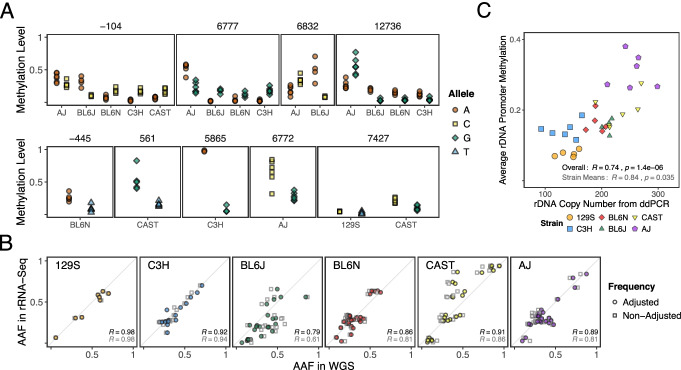Fig. 4.
The epiallelic nature of rDNA is a feature of other mouse inbred strains. A Allele-specific methylation levels at selected rDNA epivariants from the kidney of 5 inbred strains besides C57BL/6J (“BL6J”): 129S1/SvImJ (“129S”), C3H/HeJ (“C3H”), C57BL/6N (“BL6N”), CAST/EiJ (“CAST”), and A/J (“AJ”) (see Additional file 3: Fig. S13 for a comprehensive display of all identified epivariants). The top panel shows positions associated with C57BL/6J haplotypes. Notably, the methylation differences at these positions are not always directionally consistent across different strains where the variants are conserved. The bottom panel depicts strain-specific variants; note 7427 is variable in 2 strains, but with different alternative nucleotides (T in 129S1/SvImJ and G in CAST/EiJ). B Comparison of alternative allele frequencies (AAF) at the epivariant positions between rDNA (WGS) and rRNA for one representative mouse of each strain (see Additional file 3: Fig. S14). If only unmethylated units are expressed, then adjusting the AAF ratios in the WGS by ignoring methylated copies in the ratio calculations should improve the correlation between variant frequencies (i.e., unmethylated correlated with expressed). This is observed in 4/6 strains. C Total rDNA copy number from ddPCR correlated with methylation level from WGBS across the different mouse strains. Correlation coefficients displayed use all mice as data points (black) or a single average point per strain (gray). The analysis was repeated using the highly conserved 18S subunit only to exclude any possibility that the results are due to strain-specific differences in mapping efficiency (see Additional file 3: Fig. S15)

